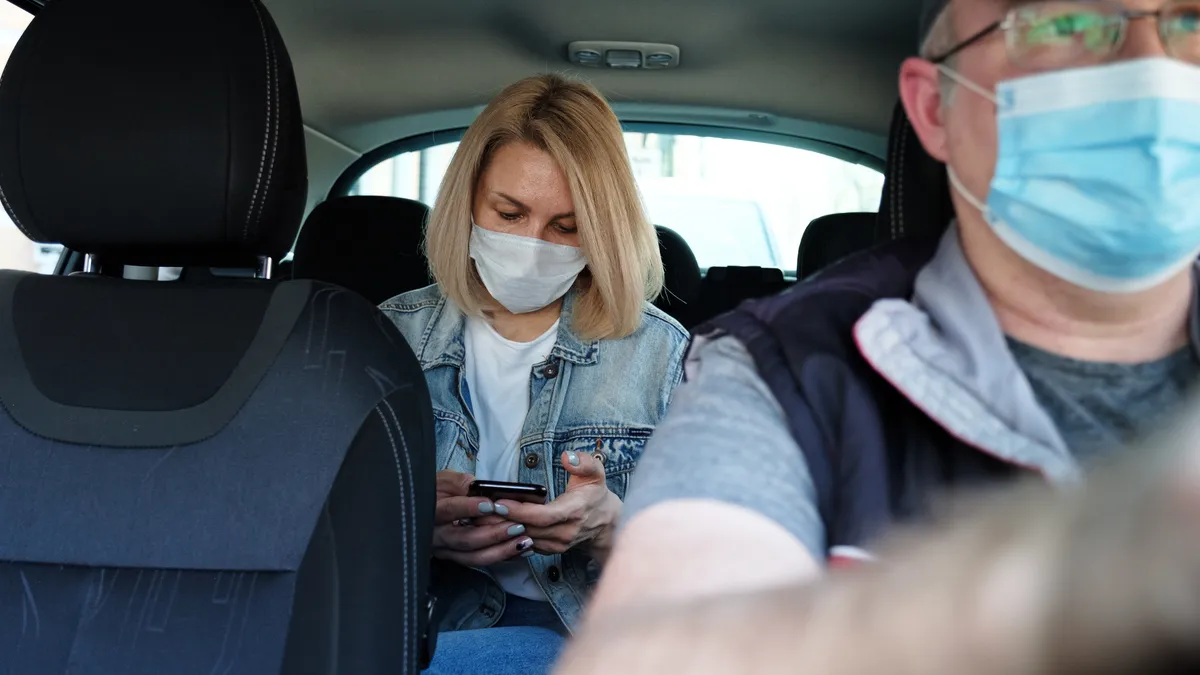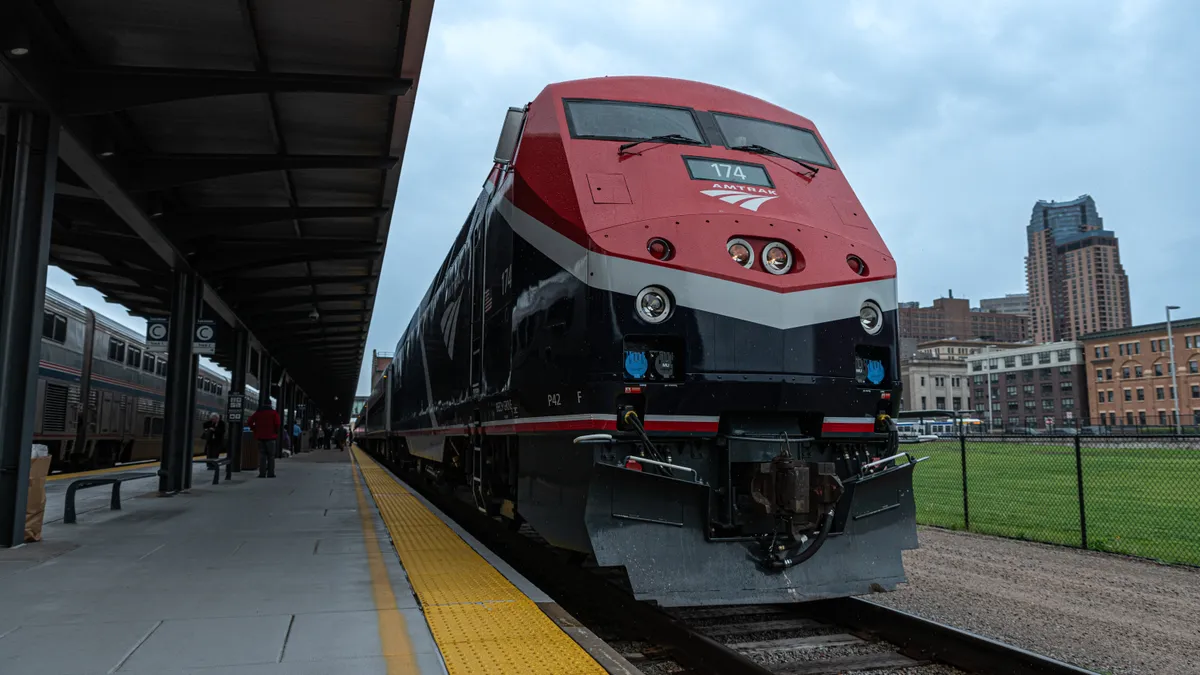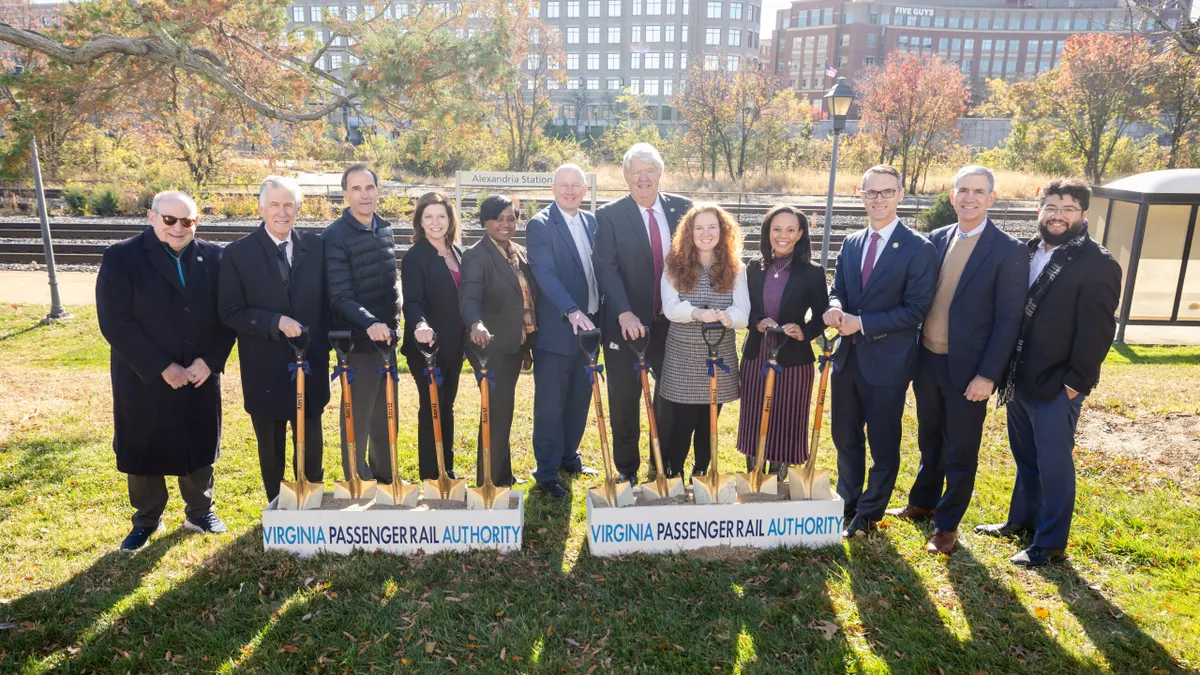After months of low ridership amid the COVID-19 pandemic, transportation network companies (TNCs) are hoping to enter their "new normal" with a number of adopted and planned initiatives to help customers once again feel comfortable hailing a ride.
These initiatives include face mask mandates for riders and drivers alongside vehicle sanitization requirements. For Lyft and Via, it also includes plans to install plexiglass dividers in vehicles to prevent the spread of germs.
Despite these efforts, some experts suggest COVID-19 could force a reckoning regarding the long-term viability of ride-hailing services. It could also bring into question the future of previous offerings like shared rides — especially as residents and commuters turn to personal vehicles in a bid to stay safe.
Protection in the short term
TNC customer loyalty will hang in the balance as companies' COVID-19 response plans unfold in the coming months, according to public polling released by the Boston Consulting Group in June.
The study of 5,000 riders in major cities across the United States, China and Western Europe found that demand for ride-hailing has shrunk precipitously amid the pandemic. Respondents ranked social distancing and cleanliness as the two most important criteria for returning to ride-hailing.
Luckily, some TNCs started working on such criteria before the polling was even released. In May, Uber extended its policy requiring drivers and riders to wear face masks indefinitely. The company also rolled out new technology in its app enabling drivers to confirm mask use by taking a selfie. There is a similar checklist for riders, though no requirements to take a mask selfie.
Lyft also requires face masks under its Health Safety Program, which launched in early May, per a recommendation from the Centers for Disease Control and Prevention (CDC).
"With guidance from the CDC and local officials, Lyft is taking action to build products and implement policies that help keep riders and drivers safe, as well as empower our community to protect themselves and those around them," Angie Westbrock, vice president of global operations and head of Lyft's COVID-19 Response Task Force, said in an emailed statement.
"Drivers hate shared rides. They were never fans of shared rides, because it was more work for about the same if not less money."

Harry Campbell
Founder and author, The Rideshare Guy and The Rideshare Guide
In the early days of the pandemic, Uber and Lyft both elected to suspend their shared ride services, promising their return once the spread of the infection is at least under control. Officials suggest shared rides will be key to alleviating the negative impacts of vehicular traffic when residents and commuters are back on the road.
"Coming out of this, there will be still a lot of demand for transportation that is economical, that is environmentally more sustainable than single-occupancy vehicles," Chris Pangilinan, Uber's head of global policy for public transportation, said during a webinar in April hosted by the Intelligent Transportation Society of America. "The need and the desire for something like a Pool service will be important."
But the return of shared rides may not be welcomed by ride-hailing drivers, who dislike the economics of the initiative and may have continued concerns about the infection spread.
"Drivers hate shared rides," Harry Campbell, founder of blog The Rideshare Guy and author of The Rideshare Guide, said. "They were never fans of shared rides, because it was more work for about the same if not less money, and to be honest, even on the riders' side, I think a lot of riders didn't like sharing rides. The main reason why they opted for it was because it was cheaper, and I think it was never a product that really caught on."
More long-term safety innovations
Beyond face mask requirements, the ride-hailing industry is exploring new ways to keep riders and drivers safe, even beyond the worst of the pandemic.
In keeping with CDC recommendations, Lyft has begun distributing free vehicle partitions to some "frequent drivers," as well as those in its Express Drive rental program, in Atlanta, Denver, Los Angeles, Seattle, Baltimore and a handful of other major cities, a Lyft spokesperson said in an email. The partitions will be available for purchase by any driver in the Lyft store. The spokesperson noted that Lyft does not make a profit on the partitions and sells them at cost price, but some in the community said charging drivers for necessary safety equipment is a money grab and a needless burden.
"I talk to drivers every week who have 29 cents left in their bank account, they haven't paid the rent for two months and their children are hungry," said Nicole Moore, an organizer with California-based drivers' union Rideshare Drivers United and a part-time Lyft driver. "And they're asking me, how do they ask drivers to come back on the road, but first buy the $50 partition. It's outrageous."
Rival ride-hailing company Via is also looking to install plexiglass partitions to reduce the spread of airflow between the driver and rider. Alex Lavoie, the company's global head of operations, said Via has worked with governmental bodies like the Taxi and Limousine Commission (TLC) in New York City to become an approved plexiglass partition installer.
Some third-party companies are also sensing an opportunity with the onset of vehicle partitions. Advertising firm Nickelytics recently launched its Ad Shield, a self-installed plexiglass barrier on which companies can buy advertising space. Ad Shield offers drivers a portion of the ad revenue to help defray the costs of driving, said Nickelytics Co-Founder and CEO Judah Longgrear.
"If you look at safety, it's really just an extra layer of protection, so we still encourage drivers to leverage any kind of cleaning supplies, wiping the seats down. But this is just an extra barrier where they have blockage from particles or sneezes or coughs from the back of the vehicle to the front of the vehicle," Longgrear said. "It's additional layers of peace of mind and safety as they go about their day job and help get things back up."
REEF Technology, which operates mobility and logistics hubs and neighborhood kitchens, is another company doubling down on its offerings to aid ride-hailing drivers. REEF kicked off its Barrier initiative in New York City last month to provide sanitization and PPE bundles to drivers, with officials noting the effort is key to helping communities get back on their feet.
"Right now, as people are getting back to work and drivers are getting back driving on ride-sharing platforms and riders are thinking about ride-sharing platforms, this is something, we listened to the community and heard as a need," a REEF spokesperson said.
A murky future for ride-hailing
The BCG survey painted a somewhat troubling picture about the future of ridership, as just over 20% of respondents said they would use solo ride-hailing or taxi services less often post-COVID.
On Uber's Q1 earnings call in May, CEO Dara Khosrowshahi said the company's Rides segment is struggling. "I won't sugarcoat it. COVID-19 has had a dramatic impact on Rides with the business down globally around 80% in April," he said.
And during Uber’s Q2 earnings call last week, the company said its gross bookings across its mobility offerings declined 73% year-over-year. Despite this, Khosrowshahi said various cost-cutting measures and a realignment of focus should help the company should survive.
"Regardless of the ultimate shape of the recovery curve, I'm confident that the work we've done will ensure that we’re well positioned," Khosrowshahi said. "Our actions have strengthened our foundation, brought renewed focus and energy to our core business and have seen us operating and innovating more effectively than ever before."
To fill the shortfall in its mobility segment, the company appears to have renewed its focus on its delivery segment, which has seen 103% year-over-year growth in revenue in Q2. The company solidified this refocus in July with a $2.65 billion acquisition of Postmates.
Lyft CEO Logan Green said he foresees a similarly gloomy future for the company, with rides still down 70% year-over-year.
"Even as shelter-in-place orders and travel restrictions are modified or lifted, we anticipate that continued social distancing, altered consumer behavior and expected corporate cost-cutting will be significant headwinds for Lyft," Green said during Lyft's Q1 earnings call in May. "The strength and duration of these headwinds cannot presently be estimated."
To ensure residents and commuters can still get around, Uber has been bullish on partnering with a variety of transportation services and transit agencies, including Miami-Dade Transit and Indianapolis' IndyGo for services to support essential workers. Uber also recently acquired transit software company Routematch.
During the ITS America webinar, Uber's Pangilinan said the company will continue to partner with transit agencies amid the pandemic, especially as those agencies continue to face what he described as "extreme revenue pressures" from cratered ridership.
"[W]e anticipate that continued social distancing, altered consumer behavior and expected corporate cost-cutting will be significant headwinds for Lyft."

Logan Green
CEO, Lyft
Campbell said that despite TNC ridership being way down, recovery is possible as people will find driving themselves in a personal car the safest, followed closely by ride-hailing.
But Moore and other experts said the COVID-19 crisis has brought into an even harsher light some of the labor issues for ride-hailing drivers, who are classified as independent contractors but often work full-time hours — a practice that has been scrutinized by Congress. It is a trend that caught the attention of California legislators, who passed AB5 last year to try and curb the use of independent contractor status.
Uber and Lyft were recently ordered by a California judge to classify their drivers as employees under a temporary injunction, though Uber officials said they will appeal.
On a webinar hosted by the University of California Center for Law, among other organizations, Adam Stocker, a transportation researcher at UC Berkeley's Transportation Sustainability Research Center, said the pandemic has called into question the labor practices of ride-hailing companies. Reform may be needed, Stocker said.
"Ultimately, the COVID crisis has really magnified a lot of these issues, and that it's really pushed the precarity of gig workers and also I think broadens the amount of the public that's actually pretty aware of how low paying and how unprotected these workers are," Stocker said. "Drivers are considered to be essential workers, but they're not given these basic protections."
Many drivers want to be recognized as employees, especially as the companies' general business model is "really in a business model of having employees," Moore said. She added that it would introduce protections like sick leave and support around driver unionization, making the job much more favorable.
"Why don't we have paid sick leave? Why don't we have workers compensation if we become ill because we're driving with an infected patient?" Moore said. "You know, the safety of the passenger, and the driver is more on the driver and the passenger than it was on Lyft and Uber. I think this pandemic really brings it into focus."





















